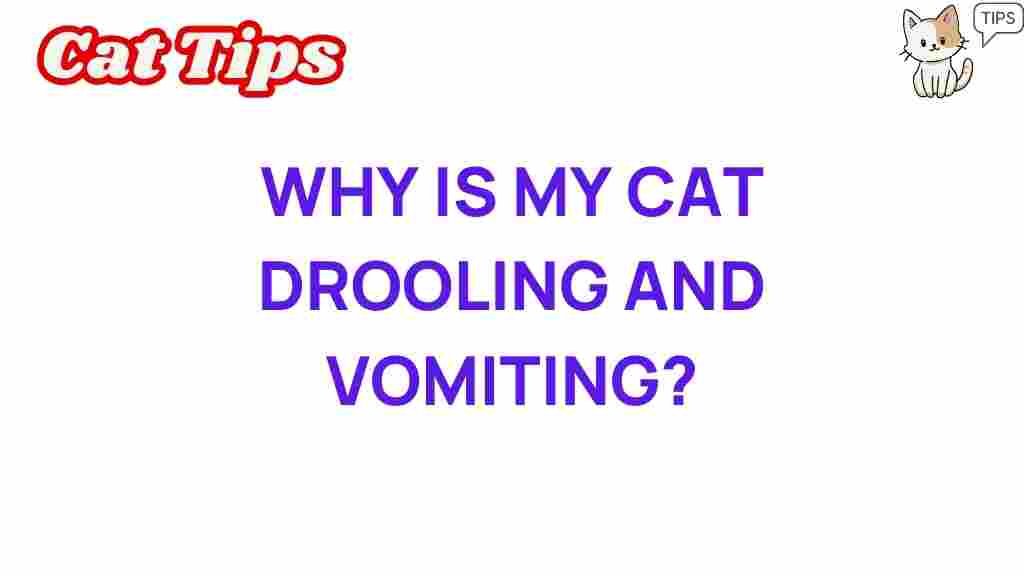Understanding Cat Health: Why Is My Cat Drooling and Vomiting?
As a cat owner, it’s essential to keep an eye on your feline friend’s health. One common concern that many cat owners face is when their beloved pet starts drooling and vomiting. These symptoms can indicate various health issues, making it crucial to address them promptly. In this article, we will delve into the possible reasons for drooling and vomiting in cats, how these symptoms relate to overall cat health, and what steps you can take to ensure your pet receives the appropriate care.
Common Causes of Drooling in Cats
Drooling can be a normal response in cats, especially when they are relaxed or experiencing something enjoyable, such as eating or being petted. However, excessive drooling can signal underlying health problems. Here are some common causes:
- Dental Issues: One of the most frequent reasons for drooling in cats is dental disease, which can cause pain and discomfort.
- Oral Injuries: Cuts or injuries in the mouth can lead to increased saliva production.
- Poisoning: Ingesting toxic substances, such as certain plants or chemicals, can cause excessive drooling.
- Gastrointestinal Problems: Conditions affecting the digestive system can result in drooling.
- Heatstroke: Cats can drool when they are overheated, and this can lead to severe health issues.
Common Causes of Vomiting in Cats
When it comes to vomiting, it’s essential to understand that cats may vomit for various reasons, ranging from minor to severe. Here are some common causes to consider:
- Dietary Indiscretion: Cats are known for eating things they shouldn’t, such as spoiled food or foreign objects.
- Hairballs: Grooming can lead to hairballs, which may result in vomiting.
- Infections: Bacterial or viral infections can cause gastrointestinal upset, leading to vomiting.
- Kidney Disease: This serious condition can cause vomiting as a secondary symptom.
- Parasites: Intestinal worms and other parasites can lead to vomiting.
How Drooling and Vomiting Relate to Cat Health
Understanding your cat’s health is crucial in identifying why your cat may be drooling and vomiting. Both symptoms can be interrelated and often indicate a more significant health issue. For instance, dental problems can lead to both drooling and vomiting if the cat is in pain or is unable to eat properly. Here’s how these symptoms may connect:
- Stress and Anxiety: Both drooling and vomiting can be signs of stress in cats. Change in environment, new pets, or other stressors can affect their well-being.
- Gastrointestinal Distress: Issues within the gastrointestinal tract can lead to vomiting and excessive salivation.
- Underlying Diseases: Conditions such as kidney disease or hyperthyroidism can manifest in both symptoms.
Step-by-Step Process: What to Do When Your Cat Is Drooling and Vomiting
If you notice your cat drooling and vomiting, it’s essential to act quickly and methodically. Here’s a step-by-step guide to help you determine the best course of action:
- Observe Symptoms: Take note of any other symptoms your cat may be exhibiting, such as lethargy, loss of appetite, or changes in behavior.
- Check for Oral Issues: Gently examine your cat’s mouth for any signs of injury, swelling, or foreign objects.
- Monitor Eating and Drinking: Keep track of your cat’s food and water intake, noting any changes.
- Review Recent Changes: Consider any recent changes in diet, environment, or routine that may have impacted your cat’s health.
- Contact Your Veterinarian: If the symptoms persist for more than a day or worsen, it’s crucial to consult a veterinarian.
Troubleshooting Tips for Cat Owners
While waiting for your vet appointment or if the symptoms are mild, here are some tips to help you troubleshoot your cat’s condition:
- Hydration: Ensure your cat stays hydrated. Offer fresh water and, if your cat is reluctant to drink, try offering ice cubes or ice chips as a fun alternative.
- Dietary Changes: If you suspect dietary issues, consider switching to a bland diet temporarily. Options like boiled chicken or specialized cat foods can help.
- Stress Reduction: Create a calm environment for your cat. Use pheromone diffusers or calming sprays to ease anxiety.
- Regular Vet Check-ups: Routine check-ups are essential for maintaining overall cat health and catching potential issues early.
Conclusion: Prioritizing Your Cat’s Health
Understanding why your cat is drooling and vomiting is essential for maintaining optimal cat health. While occasional drooling and vomiting may not be a significant concern, persistent symptoms warrant immediate attention. By observing your cat’s behavior, checking for oral health issues, and consulting with a veterinarian, you can ensure your feline friend receives the care they need.
Remember, as a responsible pet owner, staying informed and proactive about your cat’s health is crucial. If you’re ever in doubt, don’t hesitate to reach out for professional help. Your cat relies on you to provide the best care possible.
For more information on cat health and wellness, visit this resource. You can also explore various topics related to cat care on our website here.
This article is in the category Health and created by CatTips Team
